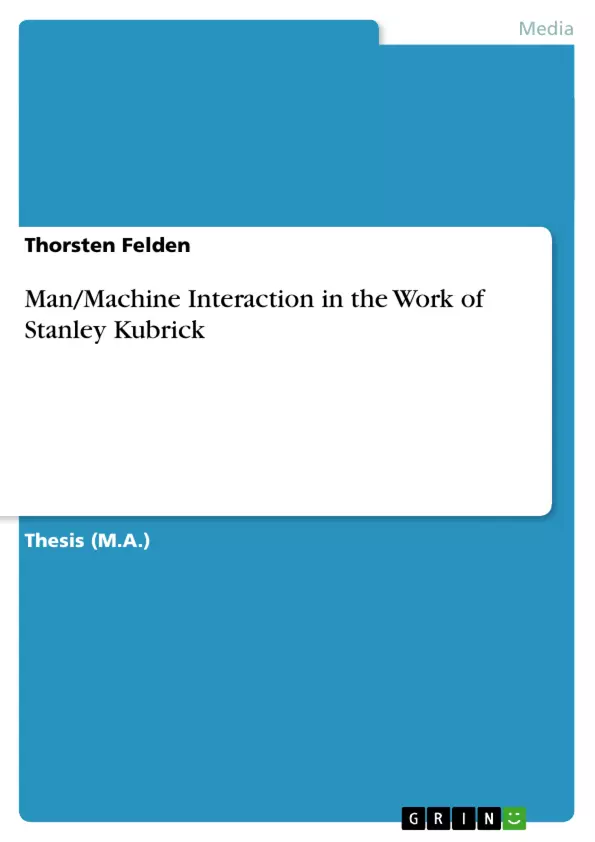In this paper, I want to examine Kubrick's work for the notion of man interacting with machines and relate it to various theoretical models that also deal with the relation of man and machine. I chose the term 'machine' as a generic term for any theory applying technological, mechanical or machinic ideas, most of which using the machine as a metaphor for sociological, philosophical or psychoanalytic approaches.
At the same time, I want to illustrate on the basis of Kubrick’s work how the theoretical discourse on this topic has changed in the course of time. Being initially cut down to a very literal understanding of machines as actual physical devices, the 20th century discourse about technology has shown that the demarcation line between what is nature and what is technology is not as easily drawn as it might appear. Man is inseparably bound up with his tools and culture as a whole could be regarded as some kind of machinery. Thus, a great part of both this paper and Kubrick's work deals with the notion of a cultural machine.
Another part, however, will leave the narrow view of the machine as a strictly cultural metaphor. Recent philosophical currents like the work of Deleuze, Maturana and the academic gender discourse try to evolve a new coining of the term ‘machinic’ that goes beyond rigid dualistic notions. I will try to show that these ideas can be found in Kubrick’s films as well.
Inhaltsverzeichnis (Table of Contents)
- Introduction – Kubrick and the Machine
- The Cultural Machine
- The Dualism of Order and Chaos
- Order
- 2001 – A Struggle for Existence?
- Closed Circuits
- Communication as an End in Itself
- System, Plan, Machine
- The Age of Reason
- Society as Theater
- Chaos
- What is Your Major Malfunction, Numbnuts?
- The Psychoanalytic Machine
- The Duality of Man
- Reboot Camp
- The Marine Symbolic
- Male Machinic Fantasy
- The Cinematic Apparatus
- The Eye and the Gaze
- Order
- Becoming Machine
- The Wedding Dance of the Machines
- Full Metal Machine
- The Marine Corps
- The Lusthog Squad
- Desire Machines and Schizoanalysis
- The World as Brain
Zielsetzung und Themenschwerpunkte (Objectives and Key Themes)
This paper explores the relationship between man and machine in the films of Stanley Kubrick, linking the director’s work to various theoretical models that also deal with this complex topic. By examining the films in light of sociological, philosophical and psychoanalytic approaches, the paper aims to demonstrate how the discourse on man-machine interaction has changed over time. The analysis focuses on Kubrick’s depiction of a ‘cultural machine’ and the inherent dualism of order and chaos, exploring themes such as communication, human aggression, and the formation of the subject.
- The evolution of man-machine interaction and its cultural implications.
- The role of technology in shaping society and the individual.
- The tension between order and chaos in human behavior and cultural structures.
- The impact of psychoanalysis and schizoanalysis on understanding human desire and the symbolic order.
- The interaction between the human subject and the cinematic apparatus.
Zusammenfassung der Kapitel (Chapter Summaries)
Chapter II examines the concept of a ‘cultural machine’ in Kubrick’s films, focusing on the interplay of order and chaos. It explores how technology influences mankind, analyzing the roles of communication, systematization, and rationality. This chapter also introduces key themes from psychoanalysis and connects them to Kubrick’s exploration of human drives and the symbolic order.
Chapter III shifts the focus to more contemporary philosophical currents that challenge traditional dualistic notions. It analyzes Kubrick’s work through the lens of Deleuze, Maturana, and the academic gender discourse, exploring concepts such as becoming-machine, the body without organs, and the war machine.
Schlüsselwörter (Keywords)
The main keywords and focus topics of this paper include man/machine interaction, cultural machine, order and chaos, communication, psychoanalysis, schizoanalysis, desiring-machines, the body without organs, the war machine, and the cinematic apparatus.
- The Dualism of Order and Chaos
- Arbeit zitieren
- Thorsten Felden (Autor:in), 2006, Man/Machine Interaction in the Work of Stanley Kubrick, München, GRIN Verlag, https://www.grin.com/document/75545



